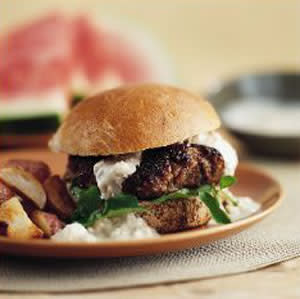What’s in your veggie burger? The truth behind mystery ingredients

A trip down the frozen-food aisle of any major supermarket confirms that the nonmeat burger is more mainstream than fringe these days. With dozens of choices at your fingertips, navigating the world of burger alternatives can be challenging. Moreover, what are all those ingredients listed on the package of your soy-based veggie burger? Rest assured, they're not as scary as they sound. We explain the purpose of some mysterious ingredients commonly spotted on the labels of meat-free burgers.
Protein Packers: textured vegetable protein, soy protein isolate, soy protein concentrate (listed in order from least to most processed)
A source of high-quality protein, the soybean is the foundation for many vegetarian burgers. Manufacturers often blend less-processed (and more nutritious) forms of soy with more highly processed soy that contributes an appealingly chewy, meatlike texture.
Homemade alternative: Chickpea Burger & Tahini Sauce. Just one "burger" boasts 30% of your daily value for protein.
Binders & Stabilizers: vegetable gum, maltodextrin, methylcellulose
These ingredients help hold everything together in a neat, firm patty. Generally, they are starches or fibers derived from natural plants (including bushes, trees, seaweed) and bacteria. You'll find them in nearly any processed food. Since they are added in such small amounts, their nutritional impact is negligible.
Homemade alternative: Mediterranean Burger. It's bound together with millet, a fiber-rich grain that adds texture and lends a pleasantly mild flavor.
Flavor Infusers: natural flavor 1 , yeast extract 2 , disodium guanylate 3 , disodium inosinate 3 , succinic acid 3 , sodium phosphate 4
Somewhat like the sugar and cheese, onion and garlic powders also listed on labels, these less familiar ingredients contribute to, or enhance, the flavor of your burger.
1. natural flavor: This term refers to one or more ingredients derived from a plant or animal (i.e., not created in a lab) and added for flavor, not nutrition. Usually it reflects multiple ingredients whose proportions may vary between batches. For example, mint ice cream's "natural flavor" may come from several mint types (peppermint, spearmint, etc.). "Natural flavor" may conceal proprietary formulas: one company that makes soy burgers confessed that using the term keeps its herb-and-spice blend "secret." Bottom line: Food makers don't use this vague term to trick consumers (to puzzle rivals, maybe); in fact, the FDA requires that ingredients associated with food sensitivities (e.g., monosodium glutamate) be identified specifically.
2. yeast extract: Compounds, including amino acids-which stimulate taste receptors-that are isolated from yeast and added to enhance flavors.
3. disodium guanylate/disodium inosinate/succinic acid: Natural acids (found in living cells) that enhance food flavors, helping to reduce the amount of salt needed.
4. sodium phosphate: Like table salt (sodium chloride), it adds flavor-and sodium-to your burger.
Homemade alternative: Veggie-Burger Pitas. Mushrooms and pine nuts pack a flavorful natural punch!
Meat Imitators: sunflower oil, soybean oil, corn oil, niacinamide, iron, ferrous sulfate, B1, B6, B2, B12
Vegetable oils are added to contribute the moisture and rich "mouthfeel" that, in traditional hamburgers, (less healthful) beef fat provides. Also, some brands are fortified with nutrients one might miss by not eating meat.
Homemade alternative: Pecan & Mushroom Burgers. Filled with toasted pecans, vinegar-splashed mushrooms and bulgur, these burgers have an earthy, nutty character that pairs perfectly with a luxurious Blue Cheese Sauce.

Pecan & Mushroom Burgers
2/3 cup bulgur
3/4 teaspoon salt, divided
1 cup boiling water
6 teaspoons extra-virgin olive oil, divided
8 ounces white or brown mushrooms, stems trimmed, wiped clean and chopped
1 1/2 cups chopped onion (1 large)
1 1/2 tablespoons balsamic vinegar
3/4 cup pecan halves
Blue Cheese Sauce, optional
1 large egg, lightly beaten
1/2 cup fine dry breadcrumbs
Freshly ground pepper to taste
8 whole-wheat buns (optional)
Watercress for garnish
1. Place bulgur and 1/4 teaspoon salt in a small bowl. Pour the boiling water over, cover and set aside until the water is absorbed, about 20 minutes. Drain in a sieve, pressing out excess liquid.
2. Meanwhile, heat 2 teaspoons oil in a large nonstick skillet over medium heat. Add mushrooms, onion and remaining 1/2 teaspoon salt; cook, stirring, until the vegetables are softened, 8 to 10 minutes. Stir in vinegar. Immediately transfer the mixture to a plate and let cool to room temperature, about 30 minutes.
3. Toast pecans in a small dry skillet over medium-low heat, stirring, until fragrant, 4 to 6 minutes. Transfer to a plate to cool.
4. Prepare Blue Cheese Sauce, if using.
5. Combine the vegetable mixture and pecans in a food processor; pulse briefly until coarsely chopped. Add egg and the bulgur; pulse briefly, scraping down the sides if necessary, until the mixture is cohesive but roughly textured. Transfer to a bowl; stir in breadcrumbs and pepper. Mix well.
6. With dampened hands, form the mixture into eight 1/2-inch-thick patties, using about 1/2 cup for each.
7. Using 2 teaspoons oil per batch, cook 4 patties at a time in a large nonstick skillet over medium heat until evenly browned and heated through, about 4 minutes per side. Meanwhile, split and toast buns, if using, to serve the burgers on. Garnish the burgers with watercress and the cheese sauce, if desired.
Makes 8 servings.
NUTRITION INFORMATION: Per serving (without buns or garnishes): 197 calories; 12 g fat (1 g sat, 7 g mono); 26 mg cholesterol; 19 g carbohydrate; 5 g protein; 4 g fiber; 281 mg sodium; 241 mg potassium. 1/2 Carbohydrate Serving.
By EatingWells Dr. Rachel Johnson

Rachel Johnson, EatingWells senior nutrition advisor, is dean of the University of Vermont College of Agriculture & Life Sciences.
Related Links from EatingWell:
